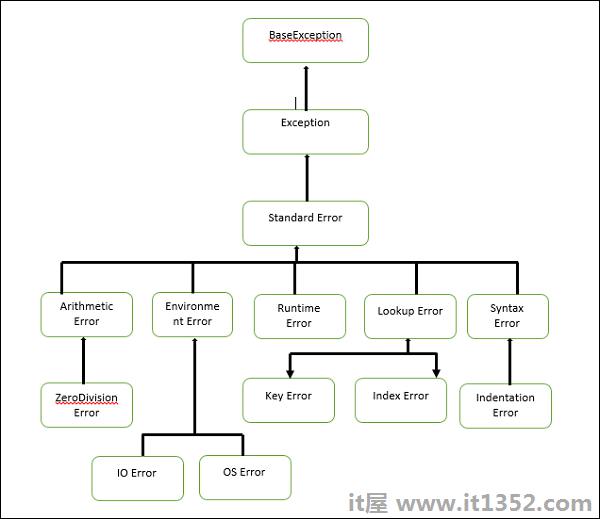一般情况下,异常是任何异常情况.例外通常表示错误,但有时他们故意放入程序,例如提前终止程序或从资源短缺中恢复.有许多内置异常,表示读取文件末尾或除以零等条件.我们可以定义自己的异常,称为自定义异常.
异常处理使您可以优雅地处理错误并对其执行一些有意义的操作.异常处理有两个组成部分:"抛出"和"捕获".
Python中发生的每个错误都会导致异常将由错误类型标识的错误条件.
>>> #Exception
>>> 1/0
Traceback (most recent call last):
File "<pyshell#2>", line 1, in <module>
1/0
ZeroDivisionError: division by zero
>>>
>>> var = 20
>>> print(ver)
Traceback (most recent call last):
File "<pyshell#5>", line 1, in <module>
print(ver)
NameError: name 'ver' is not defined
>>> #Above as we have misspelled a variable name so we get an NameError.
>>>
>>> print('hello)
SyntaxError: EOL while scanning string literal
>>> #Above we have not closed the quote in a string, so we get SyntaxError.
>>>
>>> #Below we are asking for a key, that doen't exists.
>>> mydict = {}
>>> mydict['x']
Traceback (most recent call last):
File "<pyshell#15>", line 1, in <module>
mydict['x']
KeyError: 'x'
>>> #Above keyError
>>>
>>> #Below asking for a index that didn't exist in a list.
>>> mylist = [1,2,3,4]
>>> mylist[5]
Traceback (most recent call last):
File "<pyshell#20>", line 1, in <module>
mylist[5]
IndexError: list index out of range
>>> #Above, index out of range, raised IndexError.当程序中出现异常并且您希望使用异常机制处理它时,你'抛出异常'.关键字try和except用于捕获异常.每当try块中发生错误时,Python都会查找匹配的except块来处理它.如果有,则执行跳转.
try: #write some code #that might throw some exception except <ExceptionType>: # Exception handler, alert the user
try子句中的代码将逐个语句执行.
如果发生异常,将跳过try块的其余部分,并执行except子句.
try: some statement here except: exception handling
让我们编写一些代码,看看当你在程序中没有使用任何错误处理机制时会发生什么.
number = int(input('Please enter the number between 1 & 10: '))
print('You have entered number',number)只要用户输入一个数字,上述程序就能正常工作,但会发生什么s如果用户试图放入一些其他数据类型(如字符串或列表).
Please enter the number between 1 > 10: 'Hi'
Traceback (most recent call last):
File "C:/Python/Python361/exception2.py", line 1, in <module>
number = int(input('Please enter the number between 1 & 10: '))
ValueError: invalid literal for int() with base 10: "'Hi'"现在ValueError是一种异常类型.让我们尝试用异常处理重写上面的代码.
import sys
print('Previous code with exception handling')
try:
number = int(input('Enter number between 1 > 10: '))
except(ValueError):
print('Error..numbers only')
sys.exit()
print('You have entered number: ',number)如果我们运行程序并输入一个字符串(而不是数字),我们可以看到我们得到的结果不同.
Previous code with exception handling Enter number between 1 > 10: 'Hi' Error..numbers only
提出例外情况您自己的方法需要使用像这样的raise关键字
raise ExceptionClass(‘Some Text Here’)
我们举一个例子
def enterAge(age):
if age<0:
raise ValueError('Only positive integers are allowed')
if age % 2 ==0:
print('Entered Age is even')
else:
print('Entered Age is odd')
try:
num = int(input('Enter your age: '))
enterAge(num)
except ValueError:
print('Only positive integers are allowed')运行程序并输入正整数.
Enter your age: 12 Entered Age is even
但是当我们尝试e我们得到一个负数,
Enter your age: -2 Only positive integers are allowed
您可以通过扩展BaseException类来创建自定义异常类或BaseException的子类.

从上图我们可以看到Python中的大多数异常类都是从BaseException类扩展而来的.您可以从BaseException类或其子类派生自己的异常类.
创建一个名为NegativeNumberException.py的新文件并编写以下代码.
class NegativeNumberException(RuntimeError): def __init__(self, age): super().__init__() self.age = age
上面的代码创建了一个名为NegativeNumberException的新异常类,它只包含使用super()__ init __()调用父类构造函数的构造函数,并设置年龄./p>
现在要创建自己的自定义异常类,将编写一些代码并导入新的异常类.
from NegativeNumberException import NegativeNumberException
def enterage(age):
if age < 0:
raise NegativeNumberException('Only positive integers are allowed')
if age % 2 == 0:
print('Age is Even')
else:
print('Age is Odd')
try:
num = int(input('Enter your age: '))
enterage(num)
except NegativeNumberException:
print('Only positive integers are allowed')
except:
print('Something is wrong')Enter your age: -2 Only positive integers are allowed
另一种创建自定义Exception类的方法.
class customException(Exception):
def __init__(self, value):
self.parameter = value
def __str__(self):
return repr(self.parameter)
try:
raise customException('My Useful Error Message!')
except customException as instance:
print('Caught: ' + instance.parameter)Caught: My Useful Error Message!
内置异常的类层次结构是 :
+-- SystemExit +-- KeyboardInterrupt +-- GeneratorExit +-- Exception +-- StopIteration +-- StopAsyncIteration +-- ArithmeticError | +-- FloatingPointError | +-- OverflowError | +-- ZeroDivisionError +-- AssertionError +-- AttributeError +-- BufferError +-- EOFError +-- ImportError +-- LookupError | +-- IndexError | +-- KeyError +-- MemoryError +-- NameError | +-- UnboundLocalError +-- OSError | +-- BlockingIOError | +-- ChildProcessError | +-- ConnectionError | | +-- BrokenPipeError | | +-- ConnectionAbortedError | | +-- ConnectionRefusedError | | +-- ConnectionResetError | +-- FileExistsError | +-- FileNotFoundError | +-- InterruptedError | +-- IsADirectoryError | +-- NotADirectoryError | +-- PermissionError | +-- ProcessLookupError | +-- TimeoutError +-- ReferenceError +-- RuntimeError | +-- NotImplementedError | +-- RecursionError +-- SyntaxError | +-- IndentationError | +-- TabError +-- SystemError +-- TypeError +-- ValueError | +-- UnicodeError | +-- UnicodeDecodeError | +-- UnicodeEncodeError | +-- UnicodeTranslateError +-- Warning +-- DeprecationWarning +-- PendingDeprecationWarning +-- RuntimeWarning +-- SyntaxWarning +-- UserWarning +-- FutureWarning +-- ImportWarning +-- UnicodeWarning +-- BytesWarning +-- ResourceWarning